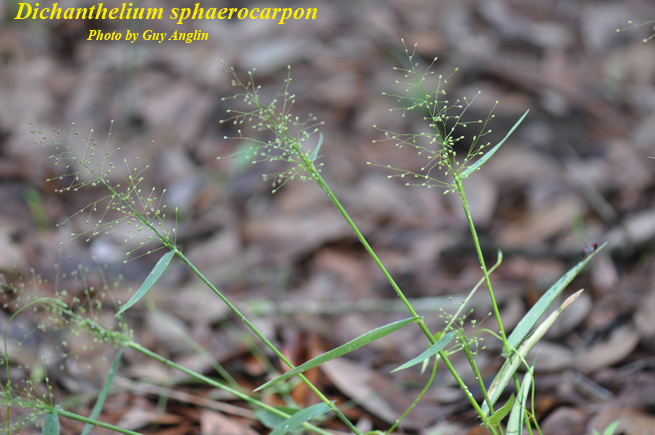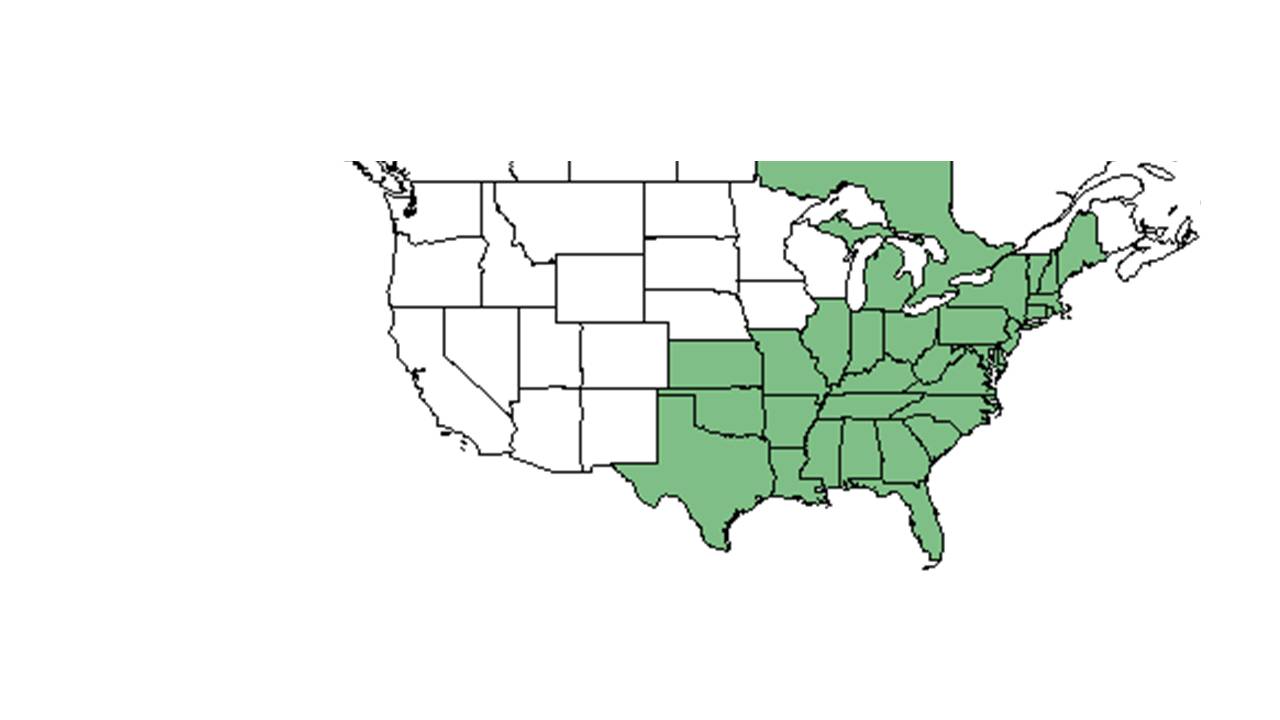Difference between revisions of "Dichanthelium sphaerocarpon"
HaleighJoM (talk | contribs) (→Ecology) |
|||
| Line 18: | Line 18: | ||
}} | }} | ||
| − | Common names: | + | Common names: roundseed panicgrass; roundseed witchgrass; round-fruited witchgrass |
==Taxonomic notes== | ==Taxonomic notes== | ||
Synonyms: ''Panicum sphaerocarpon'' Elliott; ''P. sphaerocarpon'' Elliott var. ''inflatum'' (Scribner & J.G. Smith) A.S. Hitchcock & Chase; ''P. sphaerocarpon'' Elliott var. ''sphaerocarpon''.<ref name="weakley">Weakley, A.S. 2015. Flora of the southern and mid-atlantic states. Working Draft of 21 May 2015. University of North Carolina at Chapel Hill, Chapel Hill, North Carolina.</ref> | Synonyms: ''Panicum sphaerocarpon'' Elliott; ''P. sphaerocarpon'' Elliott var. ''inflatum'' (Scribner & J.G. Smith) A.S. Hitchcock & Chase; ''P. sphaerocarpon'' Elliott var. ''sphaerocarpon''.<ref name="weakley">Weakley, A.S. 2015. Flora of the southern and mid-atlantic states. Working Draft of 21 May 2015. University of North Carolina at Chapel Hill, Chapel Hill, North Carolina.</ref> | ||
Revision as of 18:46, 25 May 2023
| Dichanthelium sphaerocarpon | |
|---|---|

| |
| Photo by Guy Anglin, Atlas of Florida Vascular Plants | |
| Scientific classification | |
| Kingdom: | Plantae |
| Division: | Magnoliophyta - Flowering plants |
| Class: | Liliopsida – Monocotyledons |
| Order: | Poales |
| Family: | Poaceae ⁄ Gramineae |
| Genus: | Dichanthelium |
| Species: | D. sphaerocarpon |
| Binomial name | |
| Dichanthelium sphaerocarpon (Elliott) Gould | |

| |
| Natural range of Dichanthelium sphaerocarpon from USDA NRCS Plants Database. | |
Common names: roundseed panicgrass; roundseed witchgrass; round-fruited witchgrass
Contents
Taxonomic notes
Synonyms: Panicum sphaerocarpon Elliott; P. sphaerocarpon Elliott var. inflatum (Scribner & J.G. Smith) A.S. Hitchcock & Chase; P. sphaerocarpon Elliott var. sphaerocarpon.[1]
Varieties: none.[1]
Description
Dichanthelium sphaerocarpon is a perennial graminoid.
Generally, for the Dichanthelium genus, they have "spikelets usually in panicles, round or nearly so in cross section, 2-flowered, terminal fertile, basal sterile, neutral or staminate. First glume usually present, 2nd glume and sterile lemma similar; fertile lemma and palea indurate without hyaline margins. Taxonomically our most difficult and least understood genus of grasses, more than 100 species an varieties are ascribed to the Carolinas by some authors. Note general descriptions for species groups (e.g., 1-4, 5-8, 9-13, and 26-62)."[2]
D. sphaerocarpon is a "perennial with distinct basal rosettes; branching, when present, from nodes above basal rosette. Leaves basal and cauline, vernal and autumnal. Culms 1,5-5 dm tall, nodes upwardly bearded, internodes glabrous. Blades to 9.5 cm long, 2-20 mm wide, glabrous or slightly scaberulous on both surfaces, margins white, scaberulous, bases cordate, ciliate; sheaths glabrous, margins papillose-ciliate; ligules obsolete or ciliate and 0.1-0.5 mm long. Panicle 4-13 cm long, 2-9 cm broad, 2/3 or more as borad as long; rachis glabrous, branches spreading-ascending, glabrous. Spikelets subglobose, 1.4-1.6 mm long; pedicels glabrous. First glume glabrous, truncate, acute, or obtuse, 0.3-0.8 mm long, 2nd glume and sterile lemma puberulent, obtuse, 1.4-1.6 mm long; fertile lemma and palea 1.3-1.5 mm long. Grain 1 mm long. yellowish or purplish, broadly ellipsoid or subglobose."[2]
Distribution
D. sphaerocarpon is native to the eastern United States including Massachusetts, Vermont, Ohio, and Kansas south to Florida and Texas. It is also native in Mexico as well as the province of Ontario in Canada.[3][4]
Ecology
Habitat
Generally, this species can be found in dry or moist thin woods, ditches, and meadows, where it is often in dry sandy soil.[3] Dichanthelium sphaerocarpon occurs in a variety of natural and disturbed communities. It is abundant in barrens habitats,[5] but also occurs in pine-oak flatwoods and woodlands, mixed hardwood floodplains, pine forests, cabbage palm hammocks, and on loessial banks, the edges of open brackish marshes, and sand dunes.[6] It is also able to grow in soil disturbed areas, especially in higher light levels. D. sphaerocarpon has been found in power line corridors, clear-cuts, roadsides, ditches, firebreaks, and old-fields. This species seems to prefer sandy or loamy soils, but can tolerate a range of moisture levels, from dry to wet.[6] It is also listed as a facultative upland species, where it most often occurs in upland non-wetland habitats, but can also occur in wetland areas.[4] D. sphaerocarpon is also considered an indicator species of the clayhill longleaf woodlands in the north Florida region.[7]
Associated species include Carex, Juncus, Sarracenia, Taxodium.[6]
Dichanthelium sphaerocarpon is an indicator species for the Clayhill Longleaf Woodlands community type as described in Carr et al. (2010).[8]
Phenology
This species generally flowers from May until October.[3] Flowering and fruiting has been observed in Florida in February through November.[6][9]
Seed dispersal
This species is thought to be dispersed by gravity.[10]
Seed bank and germination
A seed bank study found D. sphaerocarpon in higher density in the seed bank of a disturbed site, even when it was not a component of the herbaceous cover.[11]
Fire ecology
This species is commonly found in fire dependent pinelands,[7] with populations known to persist through repeated annual burns.[12][13] D. sphaerocarpon increased from being absent to 19 plots within the span of six years after an early dormant-season fire in 1989 at Gibbons Creek Barrens.[5] Another study found D. sphaerocarpon to either remain unchanged or slightly increase in frequency in response to fire.[14]
Pollination
Like other species in the Dichanthelium genus, D. sphaerocarpon is self-pollinated and the flowers remain closed.[15]
Herbivory and toxicology
D. sphaerocarpon functions as a somewhat palatable forage for cattle in the spring and late fall and does well under close grazing.[16]
Conservation, cultivation, and restoration
In a grassland restoration project in Maryland, by clearing Virginia pine (Pinus virginiana), D. sphaerocarpon was seen as a early successional species that dominated the landscape alongside D. depauperatum that slowly decreased in frequency over the years to completely disappear.[17]
Cultural use
Photo Gallery
References and notes
- ↑ 1.0 1.1 Weakley, A.S. 2015. Flora of the southern and mid-atlantic states. Working Draft of 21 May 2015. University of North Carolina at Chapel Hill, Chapel Hill, North Carolina.
- ↑ 2.0 2.1 Radford, Albert E., Harry E. Ahles, and C. Ritchie Bell. Manual of the Vascular Flora of the Carolinas. 1964, 1968. The University of North Carolina Press. 142-158. Print.
- ↑ 3.0 3.1 3.2 Weakley, A. S. (2015). Flora of the Southern and Mid-Atlantic States. Chapel Hill, NC, University of North Carolina Herbarium.
- ↑ 4.0 4.1 USDA, NRCS. (2016). The PLANTS Database (http://plants.usda.gov, 2 May 2019). National Plant Data Team, Greensboro, NC 27401-4901 USA.
- ↑ 5.0 5.1 Taft, J. B. (2003). "Fire effects on community structure, composition, and diversity in a dry sandstone barrens." Journal of the Torrey Botanical Society 130: 170-192.
- ↑ 6.0 6.1 6.2 6.3 Florida State University Robert K. Godfrey Herbarium database. URL: http://herbarium.bio.fsu.edu. Last accessed: June 2014. Collectors: Loran C. Anderson, T. MacClendon, K. MacClendon, Cecil R Slaughter, Lisa Keppner, Ed Keppner, R. Kral, Richard Carter, Charles M. Allen, Sidney McDaniel, Randy Haynes, Paul L. Hallister, Ken Rogers, Louise Rogers, Lloyd H. Shinners, Duane Isely, S L Welsh, Dwight Isely, Bayard Long, John W. Thieret, D J Banks, Fred B Jones, A. E. Radford, R. L. Wilbur, James D. Ray, Jr., Robert F. Thorne, Bob Brown, W. T. Batson Jr., H. L. Blomquist, R.K. Godfrey, P. L. Redfearn, H. Kurz, Bruce Hansen, JoAnn Hansen, Gil Nelson, Angus Gholson, Chris Cooksey, Kevin Oakes, Richard R. Clinebell II, J. M. Kane, C. Nelson, A. Clebsch, Annie Schmidt, A. Johnson, and M. Jenkins. States and Counties: Alabama: Geneva, Houston, Lee, and Monroe. Arkansas: Franklin and St. Francis. Florida: Bay, Calhoun, Collier, Escambia, Flagler, Franklin, Gulf, Holmes, Jackson, Leon, Liberty, Taylor, Wakulla, and Washington. Georgia: Baker, Dougherty, Grady, and Thomas. Kentucky: Lyon. Louisiana: Allen, Caldwell, Jackson, Ouachita, St Mary, and Union. Mississippi: Holmes, Jones, Lowndes, and Pearl River. North Carolina: Beaufort, Brunswick, Craven, and Granville. New Jersey: Gloucester. Tennessee: Putnam. Texas: Freestone, Nueces, San Augustine, and Van Zandt. Virginia: Princess Anne and Prince George. Other Countries: Honduras.
- ↑ 7.0 7.1 Carr, S. C., et al. (2010). "A Vegetation Classification of Fire-Dependent Pinelands of Florida." Castanea 75(2): 153-189.
- ↑ Carr, S.C., K.M. Robertson, and R.K. Peet. 2010. A vegetation classification of fire-dependent pinelands of Florida. Castanea 75:153-189.
- ↑ Nelson, G. PanFlora: Plant data for the eastern United States with emphasis on the Southeastern Coastal Plains, Florida, and the Florida Panhandle. www.gilnelson.com/PanFlora/ Accessed: 2 MAY 2019
- ↑ Kirkman, L. Katherine. Unpublished database of seed dispersal mode of plants found in Coastal Plain longleaf pine-grasslands of the Jones Ecological Research Center, Georgia.
- ↑ Andreu, M. G., et al. (2009). "Can managers bank on seed banks when restoring Pinus taeda L. plantations in Southwest Georgia?" Restoration Ecology 17: 586-596.
- ↑ Robertson, K.M. Unpublished data collected from Pebble Hill Fire Plots, Pebble Hill Plantation, Thomasville, Georgia.
- ↑ Platt, W.J., R. Carter, G. Nelson, W. Baker, S. Hermann, J. Kane, L. Anderson, M. Smith, K. Robertson. 2021. Unpublished species list of Wade Tract old-growth longleaf pine savanna, Thomasville, Georgia.
- ↑ Niering, W. A. and G. D. Dreyer (1989). "Effects of prescribed burning on Andropogon scoparius in postagricultural grasslands in Connecticut." American Midland Naturalist 122: 88-102.
- ↑ [[1]] Lady Bird Johnson Wildflower Center. Accessed: May 2, 2019
- ↑ Byrd, Nathan A. (1980). "Forestland Grazing: A Guide For Service Foresters In The South." U.S. Department of Agriculture.
- ↑ Tyndall, R. W. (2005). "Twelve years of herbaceous vegetation change in oak savanna habitat on a Maryland serpentine barren after Virginia Pine removal." Castanea 70(4): 287-297.